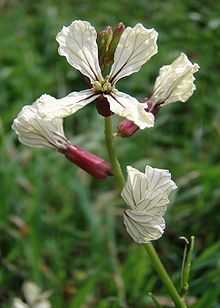Raphanus raphanistrum
| Raphanus raphanistrum | |
|---|---|
 | |
| Scientific classification | |
| Kingdom: | Plantae |
| (unranked): | Angiosperms |
| (unranked): | Eudicots |
| (unranked): | Rosids |
| Order: | Brassicales |
| Family: | Brassicaceae |
| Genus: | Raphanus |
| Species: | R. raphanistrum |
| Binomial name | |
| Raphanus raphanistrum L. | |
Raphanus raphanistrum, wild radish or jointed charlock, is a flowering plant in the family Brassicaceae. It is sometimes claimed to be the ancestor of the edible radish, Raphanus sativus. Native to Asia (or, according to some authorities, the Mediterranean), it has been introduced into most parts of the world, and is regarded as a damagingly invasive species in many, for example Australia. It spreads rapidly, and is often found growing on roadsides or in other places where the ground has been disturbed.
In southeastern USA, the pale yellow form is common, sometimes entirely taking over fields in wintertime. It is often erroneously identified as mustard. It is a significant source of pollen and nectar for a variety of pollinators, especially honey bees during the very early spring starting buildup.
Wild radish grows as an annual or biennial plant, with attractive four-petalled flowers 15-20 mm across and varying in colour, usually from white to purple but sometimes light orange to yellow, often with colour shading within a single petal. It is frost hardy, and even hard freezes only temporarily interrupt bloom. It blooms in early spring to late summer with flowers very similar to those of the searocket, which is found in some of the same regions and is easily distinguished from it by having thinner, non-succulent stems and leaves. It has a single taproot which is similar to that of the cultivated radish but less enlarged.
| Wikimedia Commons has media related to Raphanus raphanistrum. |
External links
- Jepson Manual Treatment
- USDA PLANTS database entry
- Comprehensive profile for Raphanus raphanistrum from the website MaltaWildPlants.com
- Washington Burke Museum
- UC Davis IPM
- Photo gallery
- Raphanus raphanistrum Flowers in Israel